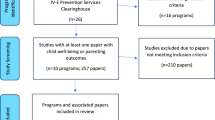Abstract
Recent years have seen the child and youth care field extend its range beyond day and residential treatment settings. These extensions have challenged traditional aspects of child and youth care worker identity. The analysis of work environment and its relationship to burnout in child and youth care workers, as compared to other social service providers, highlights the unique aspects of the field that emerge from its milieu origins in which workers engaged children and youth continuously within their life space. Milieu-based workers perceive a different work environment and respond differently to aspects of burnout. Over the years, child and youth care workers have developed their skill base and their philosophical orientation in response to the demands of milieu. As the field moves into other practice arenas, it must not lose a sense of its origins. It must strive to transport milieu oriented practices to non-milieu situations.
Similar content being viewed by others
References
Denholm, C. J. (1990). 2000 and beyond: Future career directions for child and youth care professionals.Child and Youth Services, 13(2), 347–359.
Boyd, B. J., & Pasley, B. K. (1989). Role stress as a contributor to burnout in child care professionals.Child and Youth Care Quarterly, 18(4), 243–258.
Curbow, B. (1990). Job stress in child care workers: A framework for research.Child and Youth Care Quarterly, 19(4), 215–231.
Edelwich, J., & Brodsky, A. (1980).Burn-out: Stages of disillusionment in the helping professions. NY: Human Sciences Press.
Eisikovits, Z. (1982). Managing failure in child care work: Accounting for technical incompetence through moral crusades.Child Care Quarterly, 11(3), 167–168.
Eldridge, W., Blostein, S., & Richardson, V. (1983). A multi-dimensional model for assessing factors associated with burnout in human service organizations.Public Personnel Management Journal, 12(3), 314–321.
Ferguson, R.V., & Anglin, J.P. (1985). The child care profession: A vision for the future.Child Care Quarterly, 14(2), 85–102.
Fleischer, B.J. (1985). Identification of strategies to reduce turnover among child care workers.Child Care Quarterly, 14(2), 130–139.
Freudenberger, H.J. (1977). Burn-out: Occupational hazard of the child care worker.Child Care Quarterly, 6(2), 90–99.
Fuqua, R., & Couture, K. (1986). Burnout and locus of control in child day care staff.Child Care Quarterly, 15(2), 98–109.
Hackman, J.R., & Oldham, G.R. (1980).Work redesign. Reading, MA: Addison-Wesley.
Hildebrand, J., & Seefeldt, C. (1986). Teacher burnout and environmental quality in child care centers.Child Care Quarterly, 15(2), 90–97.
Jayaratne, S., & Chess, W. A. (1984). Job satisfaction, burnout, and turnover: A national study.Social Work, 29 (5) 448–453.
Kingsley, R., & Cook-Hatala, C. (1988). A survey of child care workers: Implications for administrators regarding job stress and satisfaction.Child and Youth Care Quarterly, 17(4), 281–287.
Krueger, M.A., Fox, R.G., Friedman, J., & Sampson, J. (1987). The generic team approach.Child and Youth Care Quarterly, 16(2), 131–145.
Maier, H.W. (1990). A developmental perspective for child and youth care work.Child and Youth Services, 13(1), 7–24.
Maslach, C., & Jackson, S.E. (1981).The Maslach Burnout Inventory. Palo Alto, CA: Consulting Psychologists Press.
Maslach, C. (1982).Burnout: The cost of caring Englewood Cliffs, NJ: Prentice-Hall.
Mattingly, M.A. (1977). Sources of stress and burnout in professional child care work.Child Care Quarterly, 6(2), 127–137.
McMullen, M.B., & Krantz, M. (1988). Burnout in day care workers: The effects of learned helplessness and self-esteem.Child and Youth Care Quarterly, 17(4), 275–280.
Moos, R.H. (1974).The Social Climate Scales: An overview. Palo Alto, CA: Consulting Psychologists Press.
Moos, R.H. (1981).Work Environment Scale manual. Palo Alto, CA: Consulting Psychologists Press.
Overall, J.E., & Klett, C.J. (1972).Applied multivariate analysis. New York, NY: McGraw-Hill.
Pecora, P., & Gingerich, W. (1981). Worker tasks and knowledge utilization in group child care: First findings.Child Welfare, 60, 221–231.
Peterson, R.W. (1987). The first step for developing rejuvenation programs for professionals: An integrated definition of stress and burnout.Proceedings of the International Federation of Children's Educative Communities (FICE) Congress, Malmo, Sweden.
Pierce, L.H., & Pierce, R.L. (1982). The use of warmth, empathy, and genuineness in child care work.Child Care Quarterly, 11(4), 257–266.
Powell, D.R. (1982). The role of research in the development of the child care profession.Child Care Quarterly, 11(1), 4–11.
Raider, M.C. (1989). Burnout in children's agencies: A clinician's perspective.Residential Treatment for Children and Youth., 6(3), 43–51.
Rathbun, J.B., Webster, C.D., & Taylor, E. (1983). The nature of child care work: Structured interviews with sixty randomly selected workers from British Columbia.Journal of Child Care, 1(4), 3–21.
Rosenfeld, G.W. (1979). Turnover among child care workers.Child Care Quarterly, 8(1), 67–69.
Savicki, V. (1990). Modern times: Trends in the context of work suggesting future roles for child and youth workers.Child and Youth Services, 13(2), 291–299.
Small, R.W., & Dodge, L.M. (1988). Roles, skills and job tasks in professional child care: A review of the literature.Child and Youth Care Quarterly, 17(1), 6–23.
Wade, D.C., Cooley, E.J., & Savicki, V. (1986). A longitudinal study of burnout.Children and Youth Services Review, 8, 161–173.
Author information
Authors and Affiliations
Additional information
Special thanks to Ariel Tindolph whose dedication moved the research to a more pragmatic expression, and to Eric Cooley who supported the data reanalysis reported here.
Rights and permissions
About this article
Cite this article
Savicki, V. Clarification of child and youth care identity through an analysis of work environment and burnout. Child Youth Care Forum 22, 441–457 (1993). https://doi.org/10.1007/BF00761379
Issue Date:
DOI: https://doi.org/10.1007/BF00761379




